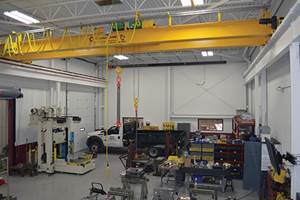If You’re Not Meaningfully Unique, You’d Better Be Cheap
These are the words of Doug Hall (www.doughall.com), founder of Eureka! Ranch and P&G brand-building wunderkind. It is also the mantra for the U.S. government’s latest initiative to lead manufacturing in this country into the new century. The goal of the new administration’s plan is to help transition discrete manufacturing companies—small and midsized manufacturers (SMMs)—from the “old” economic model (based on commodity and price) to a “new” economic model based on innovation, technology and “green.”
In other words, the government wants to help shops become inventors of products, which is believed will better position you to succeed. If you manufacture things, be sure that it is a product that is “meaningfully unique” and differentiates/distances you from your competition. If you don’t physically manufacture a product, then you will own it and enjoy that wealth.
The National Institute of Standards and Technology (NIST) and its Manufacturing Extension Partnership (MEP) network have partnered with Mr. Hall’s Planet Eureka! to create a multi-faceted program to help SMMs transition to these new business models.
- The NIST/MEP Network: This network of more than 1,600 technical advisors in all 50 states and Puerto Rico have traditionally helped SMMs adopt Lean and create new business tactics and strategies. The idea now is to shift the MEPs (usually housed in and co-sponsored by universities) from Lean to this new initiative of helping SMMs transition toward innovation, invention, marketing and selling into new markets.
- The National Innovation Marketplace (NIM; www.usainnovation.org): This online marketplace is designed to help SMMs connect with and sell ideas to larger manufacturers. Rather than simply presenting patents to prospective buyers, the NIM looks to translate the ideas of SMMs into simple language that would engage prospects and begin the negotiation process to bring those ideas to market.
- Planet Eureka!: Doug Hall’s outfit is bringing its vast experience in product innovation/development chops to bear to fuel this initiative. Its program is called MERWYN, and includes a 5-part program to translate ideas and inventions into viable business opportunities and a process that will help to automate that translation. Hall intends to help you sell the idea and the product(s).
In June, Vice President Biden used a visit to an Ohio manufacturer to announce this initiative (watch a video of the speech: http://tinyurl.com/l2glzc). I find it encouraging that this administration is focusing on manufacturing in this country, and developing a strategy that is pro-active. But on the other hand, I have to wonder if this program is sustainable for the long-term—or at least long enough to have strong economic impact.
There are many factors that must be considered beyond the retooling of the MEP network, launching an impressive marketplace and engaging a world-class manufacturing advocate and entrepreneur. What about adoption? Will the SMMs that are targeted for this program understand it? Will they have the stomach to change? Would they be willing to make the investment? Would you be willing to take the risk? I’ve seen first-hand the long road to adoption. We’re still on it. Manufacturing has been slow to adopt the Internet in general, and reluctant to accept change in markets, economies and competition, especially when it appears that the government that is offering this opportunity is seen by some to have caused most of the mess U.S. manufacturing faces in the first place.
No one is more grateful than I am that we are doing something. I also believe in open, free markets and that the globalization of businesses is a path that offers opportunities. We can compete on the global stage, with some help. But the path to U.S. manufacturing strength shouldn’t overlook other opportunities to keep U.S. manufacturing viable while change is being accepted and adopted—like lower taxes, less regulation and less government intervention. Now that would be a unique approach, and it would give many of us time to make the changes proposed by this initiative.
Related Content
OEE Monitoring System Addresses Root Cause of Machine Downtime
Unique sensor and patent-pending algorithm of the Amper machine analytics system measures current draw to quickly and inexpensively inform manufacturers which machines are down and why.
Read MoreMold Design Review: The Complete Checklist
Gerardo (Jerry) Miranda III, former global tooling manager for Oakley sunglasses, reshares his complete mold design checklist, an essential part of the product time and cost-to-market process.
Read MoreThe Trifecta of Competitive Toolmaking
Process, technology and people form the foundations of the business philosophy in place at Eifel Mold & Engineering.
Read MoreMaking Quick and Easy Kaizen Work for Your Shop
Within each person is unlimited creative potential to improve shop operations.
Read MoreRead Next
How to Use Continuing Education to Remain Competitive in Moldmaking
Continued training helps moldmakers make tooling decisions and properly use the latest cutting tool to efficiently machine high-quality molds.
Read MoreAre You a Moldmaker Considering 3D Printing? Consider the 3D Printing Workshop at NPE2024
Presentations will cover 3D printing for mold tooling, material innovation, product development, bridge production and full-scale, high-volume additive manufacturing.
Read More

















